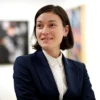Exploring Christine Sun Kim’s Artistic Evolution
Before exploring Christine Sun Kim’s retrospective at the Whitney Museum of American Art, I didn’t fully grasp the depth of her artistry.
I mistakenly viewed her work as divided into two phases: one focused on unique forms in her early pieces and another emphasizing critical political themes in her later creations.
In those initial artworks, she displayed impressive insight into sound, arising from the heightened auditory awareness her Deafness brings.
In contrast, her subsequent works, especially her drawings, tackled issues of ableism, blending humor with sharp social commentary through text.
However, the Whitney exhibition illuminated the compelling connection between these two artistic approaches.
Kim’s widely celebrated drawings poignantly illustrate the challenge of having marginalized voices constantly explain their realities.
Using charcoal on stark white paper, she translates signs from American Sign Language (ASL) into striking visuals that showcase the language’s intricate beauty.
One standout piece, “Too Much Future,” features a dynamic diagram of the sign for “future.” The elongated line representing a hand’s movements takes center stage, effectively capturing a complex grammatical structure that may be unfamiliar to many English speakers.
This piece evokes the anxiety prevalent during Trump’s presidency, reminding us that ASL can be much more than a communication tool—it can express profound meaning.
The Intersection of Humor and Advocacy
Kim’s exploration didn’t stop at ASL illustrations.
She also ventured into playful pie charts and diagrams that humorously portray the triumphs and challenges of Deaf experiences.
In her “Why My Hearing Partner Signs” pie chart, for instance, a playful lyric from the Spice Girls invites viewers to engage with her perspective in a light-hearted yet meaningful way.
During the exhibition’s opening, I noticed guests captivated by these charts as they reflected on experiences they hadn’t previously considered—a demonstration of the power of recognition.
At the outset, I appreciated Kim’s sound-centric works as standalone pieces of art.
For example, “The Grid of Prefixed Acousmatics” translates complex concepts from sound studies into captivating ceramic sculptures, while “Close Readings,” a multi-channel video, features Deaf friends interpreting classic film scenes related to voice in a range of tones from humorous to incisive.
Yet, it became clear that Kim’s drawings resonated most profoundly with audiences.
Many of these pieces date back to 2012.
Following her impactful billboards for the High Line and her notable participation in the 2019 Whitney Biennial, awareness of the experiences and accessibility needs of disabled individuals began to shift, allowing for a broader conversation—even if some initial viewer reactions seemed patronizing.
A turning point in Kim’s influence came in 2020 when she performed the National Anthem at the Super Bowl, an event that highlighted both progress and obstacles, as portions of her performance were cut, leaving Deaf viewers confused.
A Celebration of Deaf Identity
My earlier belief that Kim’s drawings were primarily tools for social change rather than legitimate art has evolved.
Viewing her work at the Whitney reinforced the notion that these pieces possess genuine artistic merit.
While their simple black-and-white aesthetic might lend themselves to digital reproduction, Kim’s choice to hand-create them imbues them with a personal touch—smudged charcoal, corrections, and even contributions from her daughter all add layers to each piece.
Drawing inspiration from twentieth-century avant-garde movements, Kim incorporates elements from Fluxus and Happening performances that emphasize direct engagement and communication.
In contrast to our digitally dominated lives, the human connection embedded in her work amplifies its impact, allowing audiences to resonate with it more deeply.
Moreover, these drawings reveal a vibrant culture tied to Deaf identity—a unique community worthy of recognition.
One of my favorite sections in the exhibition features diagrams that break down ASL phrases, showcasing how certain expressions carry distinctive grammatical structures rooted in cultural nuances.
Kim’s collaborative kinetic sculpture, “ATTENTION,” with its bright, inflatable arms playfully swaying beside a rock, adds a whimsical element—alluding to the inflatable figures often seen at car washes while emphasizing the tactile nature of communication.
While Christine is a close friend of mine, I generally refrain from reviewing the work of those I know.
However, I am increasingly concerned about the narratives around disabled artists that often lean toward portraying them as fragile, framing their accomplishments as surprising.
We stand at a significant crossroads, ready to engage in conversations that go beyond mere explanations of our lives.
Kim’s exhibition represents a pivotal moment—one of the first major showcases allowing a disabled artist to express her creativity in such a rich, multifaceted manner.
Recognizing and celebrating this opportunity is crucial, as the stakes for understanding and amplifying diverse voices within our society have never been higher.


